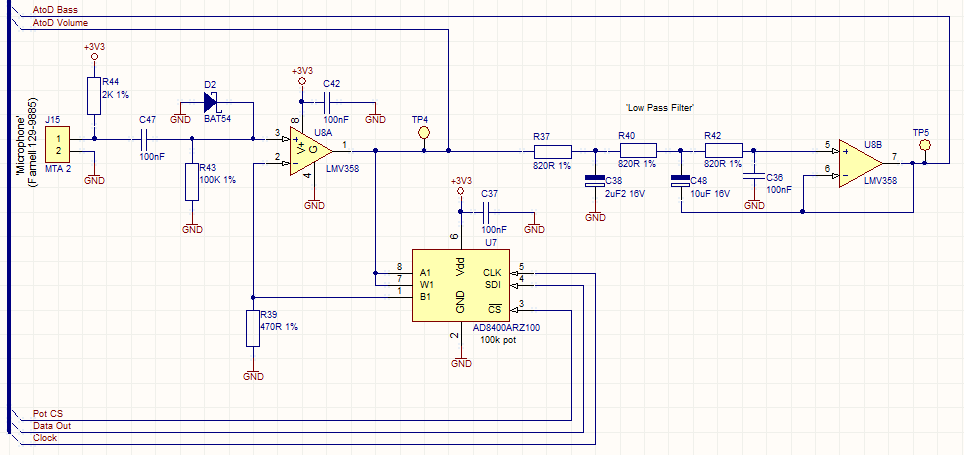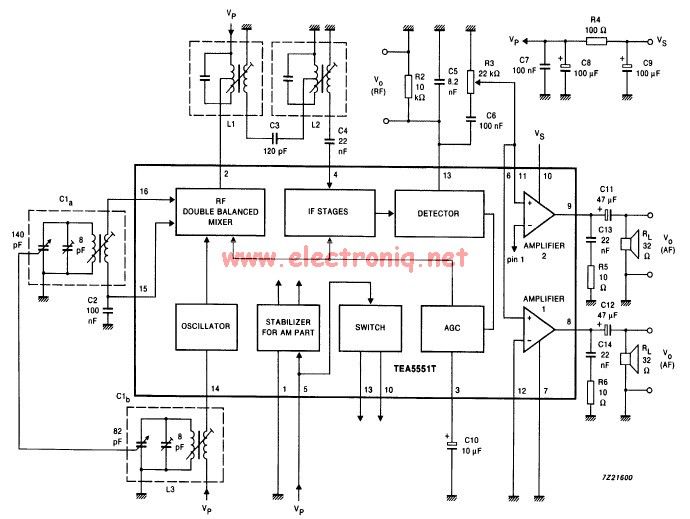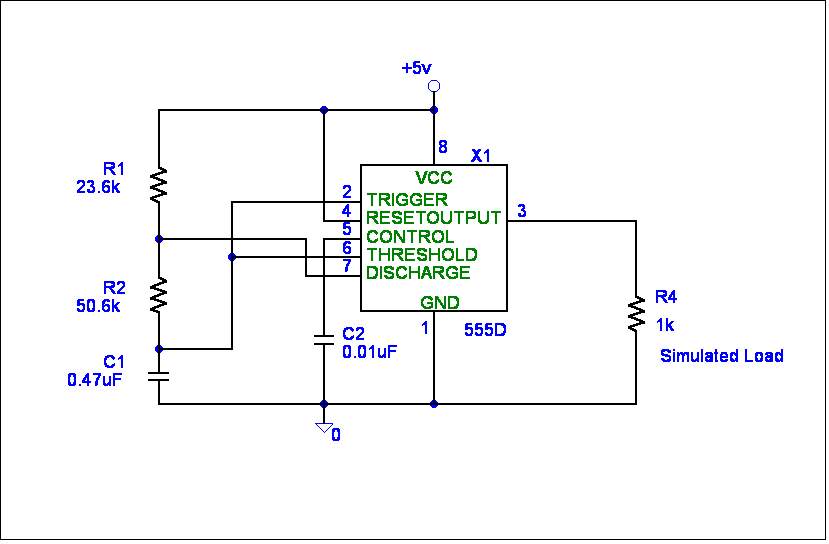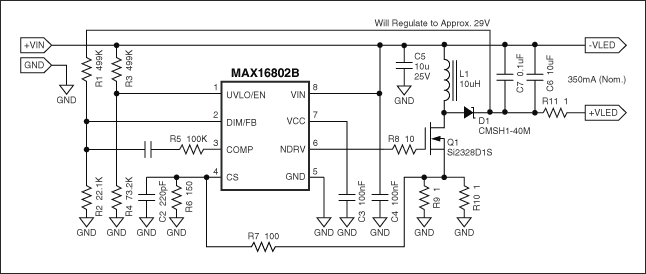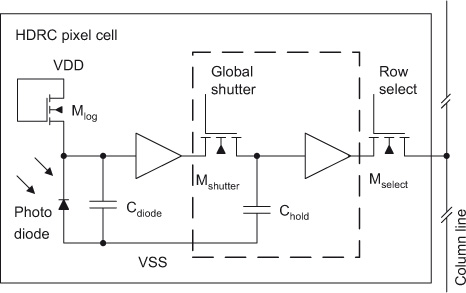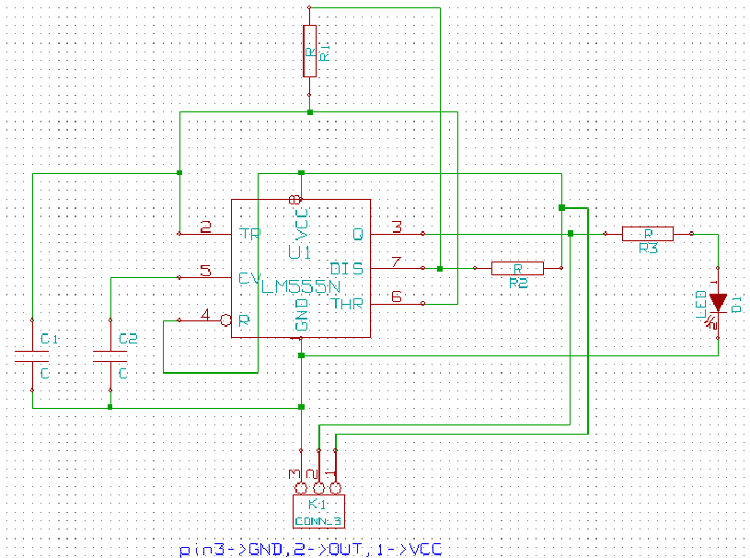
Systems Design Datagoo documentation
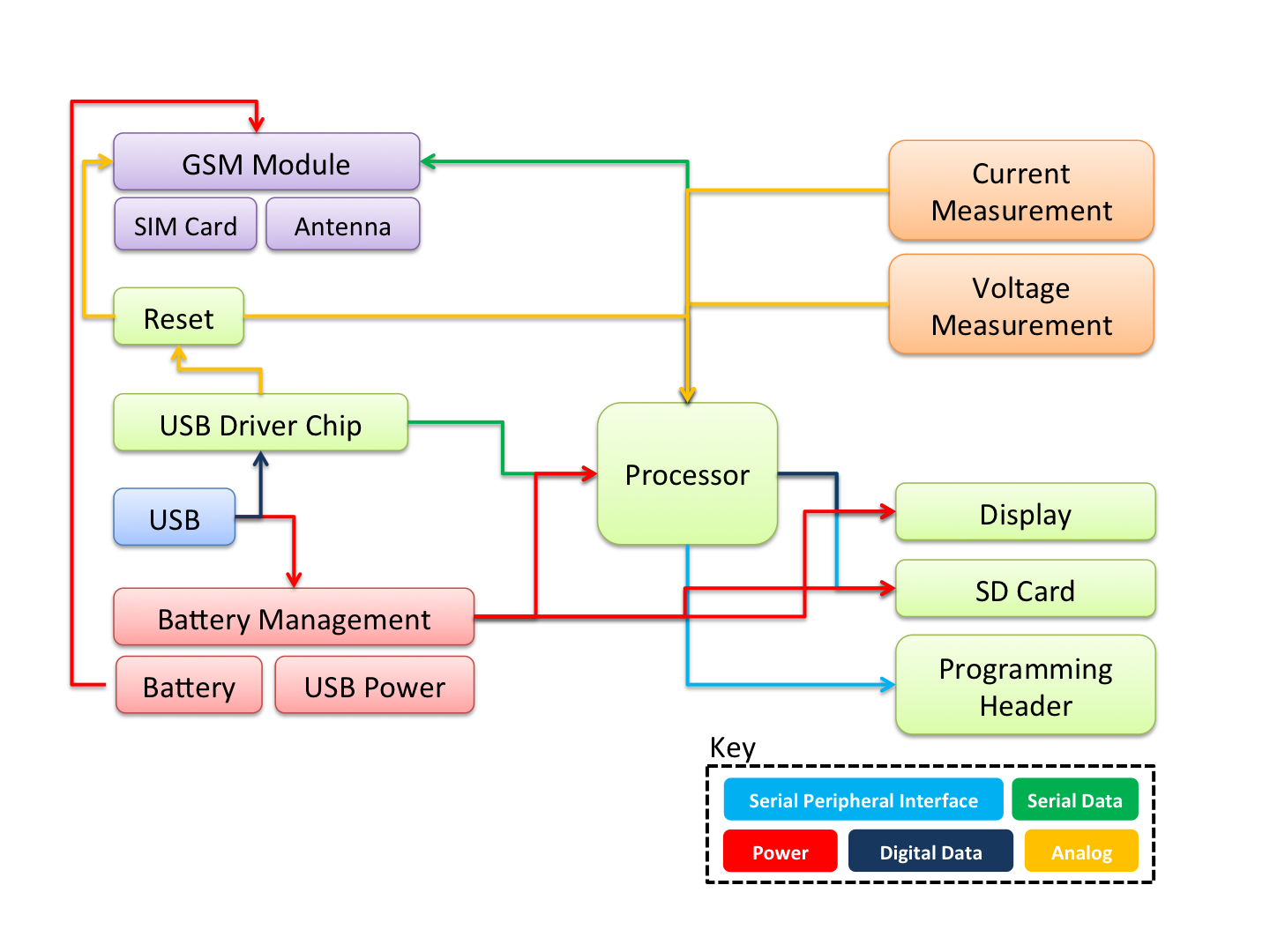
Datagoo is based on the ATMEGA328P microcontroller, widely used by hobbyists in various Arduino projects. It can be programmed via any computer with a USB port when paired with an FTDI FT232RL USB-Serial circuit. Cost-effectiveness and simplicity were prioritized in the design, leading to the use of surface mount components for easier manufacturing. The voltage and current measurement circuits leverage the ATMEGA328P's internal Analog-to-Digital converters, further minimizing component costs. A budget-friendly GSM module was selected for the design, making it one of the most affordable options available. Additionally, components requiring critical software are available in Arduino shield format, facilitating the testing of custom applications.
The input voltage is processed through a bridge rectifier, followed by a voltage divider that reduces the voltage by a factor of 110. The resulting 3.3V signal is buffered by an operational amplifier to enhance measurement accuracy before being input into the ATMEGA328P's Analog Input 1. A current transformer is employed to convert an AC signal into a readable value, effectively scaling down the current. For this current transformer, a current of 100A yields an output current of 33mA. This current flows through a small resistor (33 ohms) to generate a voltage, which is then referenced against half of 3.3V to allow for the detection of both positive and negative currents. This signal is subsequently sent to the ATMEGA328P's Analog Input 0.
Datagoo is equipped with a small lithium backup battery that maintains device operation during power interruptions. The battery, typically charged by the USB charger, has a nominal voltage of 4.2V. If USB power is lost, the device seamlessly switches to battery power, which is expected to last approximately 30 minutes. The device features a two-digit seven-segment display that indicates the amount of kilowatts being measured. This display is multiplexed, with only one segment illuminated at a time, resulting in a slight flicker. A SM5100b GSM module is integrated to provide cellular network functionality, allowing the device to send status text messages using the account information from a SIM card configured in the system. It is essential to modify the configuration file to match the GSM network settings specific to the user's country.
Furthermore, Datagoo can read and write files to an SD card, which is utilized for logging power generation data and recording any faults. Users are required to edit a configuration file to enable the device's operation.
The schematic design of Datagoo integrates several key components. The ATMEGA328P serves as the central processing unit, interfacing with the FTDI FT232RL for USB communication. The voltage measurement circuit employs a bridge rectifier followed by a voltage divider, ensuring that the ATMEGA328P operates within its specified voltage range. The operational amplifier is configured to buffer the 3.3V signal, enhancing the precision of the analog readings.
The current transformer is connected in series with the load, and its secondary output is routed through a 33-ohm resistor to convert the current into a measurable voltage. This voltage is then conditioned to allow for both positive and negative current sensing, providing a comprehensive view of the power consumption.
The lithium backup battery is connected to a charging circuit that allows it to be charged while the device is powered via USB. A power management system is implemented to switch between USB and battery power seamlessly, ensuring uninterrupted operation.
The GSM module interfaces with the ATMEGA328P through serial communication, enabling the device to send messages based on the user-defined configuration. The SD card interface allows for data logging and retrieval, providing users with a means to track performance and identify issues over time.
Overall, the Datagoo design exemplifies a well-integrated approach to low-cost, efficient power measurement and monitoring, leveraging widely available components and technologies to deliver a versatile and user-friendly solution.Datagoo is built around the ATMEGA328P, the same processor used by many hobbyists for a variety of Arduino designs. When coupled with an FTDI FT232RL USB-Serial circuit, the board can be programmed with any computer with a USB port.
Other design decisions were made in the interest of cost and simplicty. Surface mount components were chosen for eas e of manufacturing. The voltage and current measurement circuits were designed to utilize the ATMEGA328P`s internal Analog-to-Digital converters, again reducing the component cost. The cell phone module was chosen for price - it is one of the cheapest GSM modules available. Also, all the components for which critical software needed to be written are avaiable in Arduino shield form, making testing custom applications more accessible.
The input voltage is rectified with a bridge rectifier. Then, a voltage divider reduces the voltage by a factor of 110. Then, the now 3. 3V signal is run through an op-amp buffer for measurement accuracy. Finally, the signal is fed into the ATMEGA328P`s Analog Input 1. The Datagoo uses a current transformer to convert an AC signal into a readable value. A current transformer simply divides the current down. For our current transformer, a current of 100A will result in an output current of 33mA. The current is driven across a small resistor (33 ohms) to generate a voltage, which is then referenced against 1/2 * 3. 3V, so both positive and negative currents can be sensed. The signal is then fed into the ATMEGA328P`s Analog Input 0. Datagoo uses a small lithium backup battery to keep the device on in the event of a power interruption.
The battery is normally charged by the USB charger, and should be nominally at 4. 2V. If the USB power is disconnected, the device switches to battery power and should last for ~30 minutes. The display is a two digit, seven segment display that is used to show the amount of kilo-Watts currently being measured by the device.
The display is multiplexed - only one segment is on at a time, hence the faint flicker. A SM5100b GSM module is used to add cell network functionality to the Datagoo. Using the account information from a SIM card, it will send status text messages to the number written down in the configuration file. Since GSM network settings are specific to the country, make sure to change the right settings in the configuration file.
The Datagoo is capable of reading and writing files to a SD card. This is used to log the amount of power generated as well as any faults. The user must edit a configuration file in order to use the unit. 🔗 External reference
The input voltage is processed through a bridge rectifier, followed by a voltage divider that reduces the voltage by a factor of 110. The resulting 3.3V signal is buffered by an operational amplifier to enhance measurement accuracy before being input into the ATMEGA328P's Analog Input 1. A current transformer is employed to convert an AC signal into a readable value, effectively scaling down the current. For this current transformer, a current of 100A yields an output current of 33mA. This current flows through a small resistor (33 ohms) to generate a voltage, which is then referenced against half of 3.3V to allow for the detection of both positive and negative currents. This signal is subsequently sent to the ATMEGA328P's Analog Input 0.
Datagoo is equipped with a small lithium backup battery that maintains device operation during power interruptions. The battery, typically charged by the USB charger, has a nominal voltage of 4.2V. If USB power is lost, the device seamlessly switches to battery power, which is expected to last approximately 30 minutes. The device features a two-digit seven-segment display that indicates the amount of kilowatts being measured. This display is multiplexed, with only one segment illuminated at a time, resulting in a slight flicker. A SM5100b GSM module is integrated to provide cellular network functionality, allowing the device to send status text messages using the account information from a SIM card configured in the system. It is essential to modify the configuration file to match the GSM network settings specific to the user's country.
Furthermore, Datagoo can read and write files to an SD card, which is utilized for logging power generation data and recording any faults. Users are required to edit a configuration file to enable the device's operation.
The schematic design of Datagoo integrates several key components. The ATMEGA328P serves as the central processing unit, interfacing with the FTDI FT232RL for USB communication. The voltage measurement circuit employs a bridge rectifier followed by a voltage divider, ensuring that the ATMEGA328P operates within its specified voltage range. The operational amplifier is configured to buffer the 3.3V signal, enhancing the precision of the analog readings.
The current transformer is connected in series with the load, and its secondary output is routed through a 33-ohm resistor to convert the current into a measurable voltage. This voltage is then conditioned to allow for both positive and negative current sensing, providing a comprehensive view of the power consumption.
The lithium backup battery is connected to a charging circuit that allows it to be charged while the device is powered via USB. A power management system is implemented to switch between USB and battery power seamlessly, ensuring uninterrupted operation.
The GSM module interfaces with the ATMEGA328P through serial communication, enabling the device to send messages based on the user-defined configuration. The SD card interface allows for data logging and retrieval, providing users with a means to track performance and identify issues over time.
Overall, the Datagoo design exemplifies a well-integrated approach to low-cost, efficient power measurement and monitoring, leveraging widely available components and technologies to deliver a versatile and user-friendly solution.Datagoo is built around the ATMEGA328P, the same processor used by many hobbyists for a variety of Arduino designs. When coupled with an FTDI FT232RL USB-Serial circuit, the board can be programmed with any computer with a USB port.
Other design decisions were made in the interest of cost and simplicty. Surface mount components were chosen for eas e of manufacturing. The voltage and current measurement circuits were designed to utilize the ATMEGA328P`s internal Analog-to-Digital converters, again reducing the component cost. The cell phone module was chosen for price - it is one of the cheapest GSM modules available. Also, all the components for which critical software needed to be written are avaiable in Arduino shield form, making testing custom applications more accessible.
The input voltage is rectified with a bridge rectifier. Then, a voltage divider reduces the voltage by a factor of 110. Then, the now 3. 3V signal is run through an op-amp buffer for measurement accuracy. Finally, the signal is fed into the ATMEGA328P`s Analog Input 1. The Datagoo uses a current transformer to convert an AC signal into a readable value. A current transformer simply divides the current down. For our current transformer, a current of 100A will result in an output current of 33mA. The current is driven across a small resistor (33 ohms) to generate a voltage, which is then referenced against 1/2 * 3. 3V, so both positive and negative currents can be sensed. The signal is then fed into the ATMEGA328P`s Analog Input 0. Datagoo uses a small lithium backup battery to keep the device on in the event of a power interruption.
The battery is normally charged by the USB charger, and should be nominally at 4. 2V. If the USB power is disconnected, the device switches to battery power and should last for ~30 minutes. The display is a two digit, seven segment display that is used to show the amount of kilo-Watts currently being measured by the device.
The display is multiplexed - only one segment is on at a time, hence the faint flicker. A SM5100b GSM module is used to add cell network functionality to the Datagoo. Using the account information from a SIM card, it will send status text messages to the number written down in the configuration file. Since GSM network settings are specific to the country, make sure to change the right settings in the configuration file.
The Datagoo is capable of reading and writing files to a SD card. This is used to log the amount of power generated as well as any faults. The user must edit a configuration file in order to use the unit. 🔗 External reference
